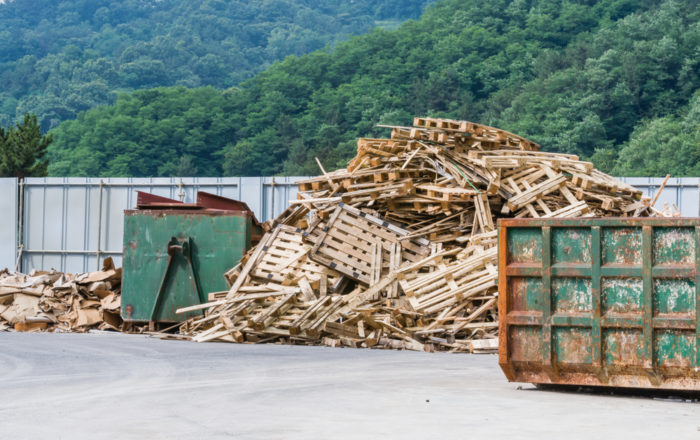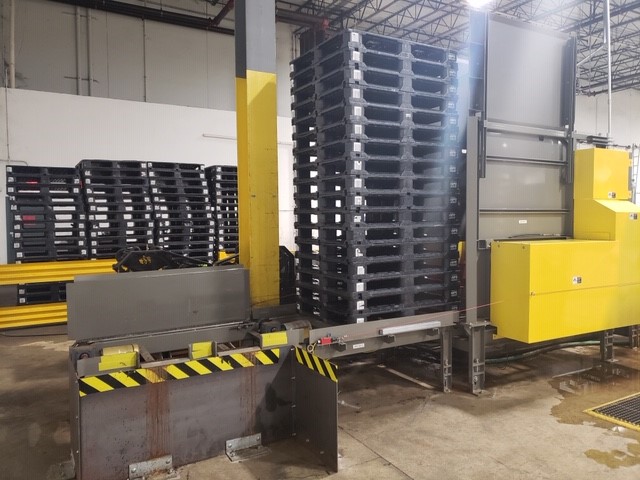Supply chain management in the circular economy focuses on eliminating waste to improve operational efficiency and cut costs. Finding opportunities to create and support a circular supply chain requires that businesses audit their processes, labor pools, and the tools that support them. By reviewing these elements with a critical eye, most supply chain managers will discover simple ways to improve production efficiency.
One major area of opportunity is the pallet fleet. Many manufacturers use outdated pallets that cause more waste than is immediately evident. If all companies switched from wooden pallets to plastic tomorrow, an estimated $750 million to $3 billion in annual supply chain waste would be eliminated. There is a clear opportunity here for supply chain managers who want to reduce waste in their supply chain and create a circular business model that will ultimately lower their Total Cost of Business (TCOB).
Why Strive for a Circular Economy?
Linear economic models create–and even depend on–an enormous amount of waste. Items like packaging are purchased with the expectation that they will reach the end of their useful lives after one trip through the supply chain. For a long time, these traditional models were a given. Companies made no real effort to avoid waste in production and transportation because resources were cheap and seemed infinite. They kept making and shipping products, paying little attention to what happened to those products and their packaging at the end of the supply chain.
Single-use packaging and transportation equipment, such as plastic wrap and stringer pallets, can be recycled or replaced with longer-lasting reusable versions.
Circular economic models challenge this idea that waste can’t be avoided; instead, they find ways to reuse or reallocate used or extra resources. These circular models seek to extend the useful lives of tools and other items by keeping them in the supply chain through repair or recycling. Machinery can be leased, rather than owned, to allow producers to pivot more easily to new technology as needed. Single-use packaging and transportation equipment, such as plastic wrap and stringer pallets, can be recycled or replaced with longer-lasting reusable versions. The circular economic model strives to close the loop in production and keep resources inside the company.
Why Single-Use Wood Pallets Aren’t a Good Fit for the Circular Economy
 Pallets play an important–and large–role in the typical supply chain. It’s estimated that 80 percent of all U.S. commerce is carried on a pallet. As a result, the type of pallet used in a supply chain will have a major impact on that manufacturer’s ability to sustain a circular business model.
Pallets play an important–and large–role in the typical supply chain. It’s estimated that 80 percent of all U.S. commerce is carried on a pallet. As a result, the type of pallet used in a supply chain will have a major impact on that manufacturer’s ability to sustain a circular business model.
Single-use wood pallets have distinct disadvantages because they have short, linear life cycles. They’re made, they’re used, and they’re trucked to landfills or ground into mulch. When a manufacturer purchases a stringer pallet, they’re getting a guarantee that, eventually, they’ll have to throw that pallet away or sell it at a loss. This directly creates waste that doesn’t support a circular supply chain or do anything to help a business’ bottom line.
Essentially, stringer pallets create waste as a byproduct of their use.
However, direct waste is not the only waste that results from wood pallet use. Wood pallets can leave behind debris and dust that increase housekeeping costs. Wood splinters and fasteners like nails and staples can come loose and damage equipment. That equipment will have to be repaired or replaced at the manufacturer’s expense, which wastes time and creates production delays. Wood particles can even get into products like food or medicine and cause contamination that leads to recalls–and, as a result, food waste.
Essentially, stringer pallets create waste as a byproduct of their use, affecting a company’s ability to build a closed-loop supply chain that will support the planet and their budget. An easy way to reduce waste in the supply chain is to switch out flimsy wood platforms for sturdier pooled platforms such as sustainable, recyclable plastic pallets.
Pooled Plastic Pallets Support Supply Chain Management in the Circular Economy
 Any change a manager can make to his supply chain that eliminates waste is a step toward a circular economic model. This is why plastic shipping platforms are an increasingly popular alternative to wood pallets. There’s no point in the lifespan of a high-quality plastic pallet in which it becomes waste. Instead, when a plastic pallet reaches the end of its useful life, it’s ground down and used to create other pallets. A plastic pallet essentially has a circular lifespan, making it the perfect choice to support a circular economic model.
Any change a manager can make to his supply chain that eliminates waste is a step toward a circular economic model. This is why plastic shipping platforms are an increasingly popular alternative to wood pallets. There’s no point in the lifespan of a high-quality plastic pallet in which it becomes waste. Instead, when a plastic pallet reaches the end of its useful life, it’s ground down and used to create other pallets. A plastic pallet essentially has a circular lifespan, making it the perfect choice to support a circular economic model.
Overall, plastic pallets contribute to the reduction of supply chain waste and are simply more sustainable.
Plastic pallets also create less indirect waste than wood pallets; for example, they don’t shed wood splinters that require cleanup. They don’t have metal fasteners that could work loose and get into packages or damage equipment. In addition, since they’re as much as 35 pounds lighter than their wood counterparts, they require less fuel during transportation. Overall, plastic pallets contribute to the reduction of supply chain waste and are simply more eco-friendly, making them a great fit for a circular, sustainable supply chain.
Pallet Pooling Is the Circular Economy in Action
Leasing pallets rather than purchasing them is another way to practice supply chain management for the circular economy. Renting pallets puts the responsibility for managing and replacing pallets in the hands of a third party specialist who is able to track, retrieve, repair, and recycle pallets in a much more efficient way than if the same assets were managed in-house.
Pallet pooling supports a circular economy because it’s a true circular model, one of a relative few being actively used in business. Both wood block pallets (which are sturdier and more reusable than basic stringer pallets) and plastic pallets can be rented through an efficient, circular pallet pool model; however, plastic pallets are even more durable than block pallets and are better suited for the circular economy. Instead of ending up in landfills, high-quality plastic pallets can be recycled into new pallets at the end of their long useful lives (a strong plastic pallet can make up to 100 trips through the supply chain, far more than a wood pallet’s typical 15 to 20 trips). Any supply chain manager who wishes to build a closed-loop supply chain should consider the low-waste, cost-saving model of plastic pallet pooling.
iGPS rents high-quality plastic pallets to help you make your supply chain part of the circular economy. Our lightweight, durable GMA spec plastic pallets can reduce your supply chain waste and make your logistics more efficient overall. For more information on our options, contact us at 1-800-884-0225, email a specialist at switch@igps.net, or visit our contact page.



